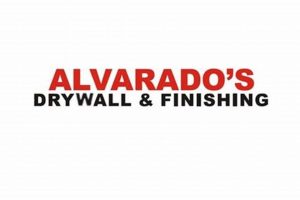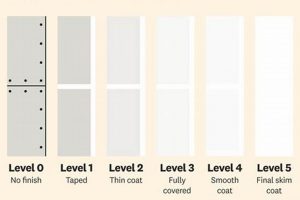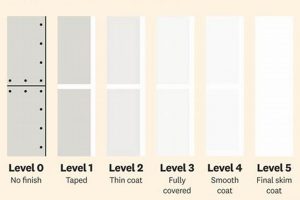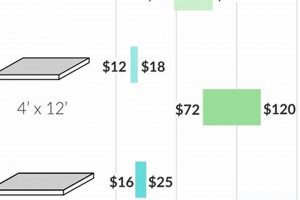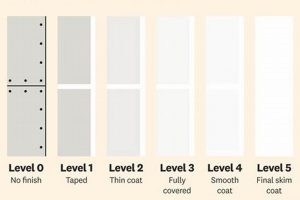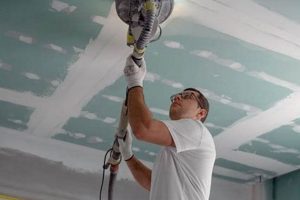A surface preparation on gypsum board panels that is suitable for many applications. This particular treatment involves embedding tape in joint compound, applying two separate coats of joint compound over all flat joints and interior angles, and sanding the entire surface smooth. Screw or nail heads are also concealed with joint compound. The resulting surface is ready for primers and paints, and is frequently specified in residences and offices.
This level of preparation provides a good base for applying texture before painting and minimizes imperfections that might be visible under normal lighting conditions. It balances cost and appearance, offering a significant upgrade over lower preparation levels while remaining more economical than higher-level finishes. Its widespread use reflects a demand for quality surfaces without excessive expenditure.
Understanding the characteristics of this preparation level is crucial when selecting the appropriate finish for drywall projects. Subsequent sections will delve deeper into application techniques, potential problems, and quality control measures applicable to achieving consistent results.
Achieving a Quality Level 4 Drywall Finish
Proper execution is key to achieving a satisfactory surface. The following guidance outlines critical aspects of the process.
Tip 1: Compound Selection: Utilize a high-quality all-purpose joint compound. Its consistency and ease of sanding significantly impact the final texture. Avoid lightweight compounds for the initial taping coat as they can be prone to cracking.
Tip 2: Tape Embedding: Ensure the taping coat is adequately pressed into the joint, removing excess compound beneath. Air pockets under the tape create bubbles, leading to surface irregularities. Check for loose tape prior to subsequent coats.
Tip 3: Feathering Technique: Feather each coat of compound well beyond the taped joint, creating a smooth transition. This minimizes the visible “hump” that can occur with poorly feathered joints. A six to eight-inch feather is generally sufficient.
Tip 4: Sanding Precision: Employ fine-grit sandpaper (120-grit or higher) for sanding. Avoid aggressive sanding, which can gouge the surface and damage the paper facing of the drywall. Sanding blocks or poles are beneficial for maintaining consistent pressure.
Tip 5: Lighting Inspection: Inspect the finished surface under direct lighting at a low angle. This reveals imperfections such as ridges, scratches, and unevenness that are difficult to see under normal conditions. Correct any detected flaws before priming.
Tip 6: Priming Importance: Always prime the surface before painting. Primer seals the joint compound, providing a uniform surface for paint adhesion. This prevents paint from absorbing unevenly, which can highlight imperfections in the finish.
Tip 7: Dust Control: Minimize dust accumulation during sanding. Employ a vacuum sander or wet sanding techniques to reduce airborne particles. Dust contaminates the joint compound and can affect paint adhesion.
Adhering to these tips significantly increases the likelihood of achieving a smooth, paint-ready surface that meets the requirements of a standard application. Meticulous preparation is paramount.
The subsequent section addresses common challenges and troubleshooting techniques associated with drywall finishing.
1. Joint Compound Application
The achievement of a surface quality is intrinsically linked to the joint compound application process. Insufficient or improper joint compound application directly leads to visible imperfections in the finished surface, precluding the possibility of achieving the level’s defined smoothness and evenness. For example, inadequate filling of screw or nail indentations results in dimples visible through the paint, failing to meet the requirement of concealed fasteners. Similarly, failure to properly embed the drywall tape results in cracking or bubbling along the joints, deviating from the desired seamless surface.
Effective application entails several crucial steps. The first coat, used to embed the joint tape, must adequately adhere to the drywall and fully encase the tape to prevent lifting or cracking. Subsequent coats require feathering a technique where the compound is gradually thinned out towards the edges of the joint. Proper feathering minimizes the appearance of ridges and transitions, contributing to the overall smoothness. Furthermore, appropriate compound selection plays a role. All-purpose compounds are frequently used, but specialized compounds may offer advantages in specific circumstances, such as faster drying times or improved sandability. Regardless of the chosen compound, adherence to the manufacturer’s instructions regarding mixing, application thickness, and drying times is essential.
In summary, the quality of joint compound application acts as a foundational element. Skillful application techniques, combined with appropriate material selection and adherence to best practices, directly influence the ability to meet the standards and aesthetic expectations. Deficiencies in this area are often irreparable without significant rework, emphasizing the importance of meticulous execution throughout the process.
2. Sanding Techniques
Sanding techniques are integral to achieving the smooth, uniform surface characteristic. The efficacy of these techniques directly determines the final visual quality and suitability of the drywall for subsequent priming and painting.
- Grit Selection
The choice of sandpaper grit directly influences the texture achieved and the risk of damage to the drywall paper. Coarse grits (e.g., 80-grit) remove material quickly but leave deep scratches unsuitable. Finer grits (e.g., 120-grit or higher) produce a smoother surface with less risk of damage. A progression of grits, starting with a slightly coarser grit and finishing with a finer one, is often employed to achieve an optimal balance between material removal and surface refinement. Using too fine a grit prematurely can also be ineffective, as it may not remove enough material to smooth imperfections efficiently.
- Sanding Pressure and Motion
Consistent, even pressure is crucial for preventing gouges and unevenness. Excessive pressure in one area creates depressions, while insufficient pressure leaves bumps and ridges. A circular or figure-eight motion is generally recommended to avoid creating directional scratches. The sanding motion should be broad and overlapping to blend the edges of the sanded area with the surrounding unsanded surface. Variations in pressure and motion result in visible inconsistencies in the final finish.
- Dust Control Methods
Effective dust control is important for both worker safety and surface quality. Excessive dust obscures the surface, making it difficult to assess the progress of the sanding and identify imperfections. Dust also contaminates the joint compound, hindering paint adhesion and creating a rougher final texture. Options for dust control include vacuum sanders, which extract dust at the point of sanding, and wet sanding techniques, which minimize airborne particles. Regular cleaning of the work area is also essential for maintaining a clean sanding environment.
- Inspection Under Light
Critical assessment of the sanded area requires inspection under direct light at a low angle. Low-angle lighting accentuates imperfections, such as ridges, scratches, and unfilled pinholes, that are difficult to detect under normal lighting conditions. Corrective sanding should be performed on any identified imperfections before proceeding to priming. Failure to adequately inspect and correct flaws results in visible defects in the painted surface, compromising the overall appearance.
In summary, the appropriate application of sanding techniques, encompassing grit selection, pressure control, dust mitigation, and meticulous inspection, is a definitive factor in achieving the refined surface that meets the specifications. Each of these facets contributes significantly to the final product and must be executed with precision.
3. Surface Smoothness
Surface smoothness constitutes a defining characteristic. Its achievement is a direct measure of the adherence to established procedures and the effectiveness of applied techniques. Deviations from optimal smoothness indicate deficiencies in material application, sanding methods, or overall quality control.
- Joint Blending
A primary aspect of surface smoothness involves the seamless blending of drywall joints. This requires precise application and feathering of joint compound to create a gradual transition between the taped joint and the surrounding drywall surface. Inadequate feathering results in visible ridges or humps along the joints, disrupting the smoothness. Effective joint blending eliminates abrupt changes in elevation, resulting in a uniform, planar surface ready for priming and painting. The smoothness of joint transitions is a critical determinant of the final aesthetic outcome, especially under varying lighting conditions.
- Imperfection Elimination
Surface smoothness necessitates the removal of surface imperfections, including nail or screw indentations, scratches, and gouges. These imperfections can arise during installation or taping and require meticulous attention during the finishing process. Thorough sanding is essential to eliminate these irregularities and create a consistent, unblemished surface. Failure to address these imperfections leads to visual defects that are amplified by paint, detracting from the overall quality of the finish. Eliminating imperfections before priming is crucial for achieving a professional result.
- Texture Consistency
Surface smoothness entails the achievement of texture consistency across the entire drywall surface. Variations in texture, such as rough patches or uneven sanding marks, disrupt the visual uniformity. Consistent sanding techniques, utilizing appropriate grit sandpaper and applying even pressure, are necessary to create a uniform texture. Texture consistency ensures that the primed and painted surface has a cohesive appearance, free from distracting irregularities. Uniformity in texture significantly enhances the aesthetic appeal and perceived quality of the final finish.
- Substrate Preparation
The smoothness is impacted by the preparation of the underlying drywall substrate. Ensuring that the drywall sheets are properly aligned and securely fastened is crucial for creating a smooth base for the finishing process. Gaps or unevenness in the drywall installation translate into surface irregularities that are difficult to correct with joint compound alone. Careful substrate preparation minimizes the amount of joint compound required and reduces the likelihood of future cracking or movement. A well-prepared substrate is fundamental to achieving a smooth and durable finish.
The considerations outlined above underscore the multifaceted nature of surface smoothness and its pivotal role in defining the overall quality. Each aspect contributes to a cohesive, refined surface that meets the established standards for an application ready for paint or other decorative finishes.
4. Concealed Fasteners
The principle of concealed fasteners is a fundamental element in the standardized specifications. The visible presence of screws or nails detracts from the smooth, uniform surface characteristic of the finish and indicates a failure to meet minimum quality standards. Achieving concealed fasteners requires meticulous attention during the application of joint compound, specifically ensuring that each fastener head is adequately covered and blended into the surrounding drywall surface. Insufficient coverage results in dimples or protrusions that are visible through subsequent layers of primer and paint, negating the intended aesthetic effect. In practical terms, the absence of visible fasteners is a readily observable metric for assessing the quality and completeness of the finishing process.
The specific techniques employed to achieve concealed fasteners include multiple applications of joint compound over each fastener head, followed by careful sanding to create a smooth, seamless transition. The initial application fills the indentation created by the fastener, while subsequent applications build up the surface to match the surrounding drywall. The sanding process blends the edges of the filled indentation with the adjacent surface, eliminating any visible evidence of the fastener. The selection of appropriate joint compound is also a factor, as some compounds shrink more than others during the drying process, potentially leading to a recessed area over the fastener head. Inspection under direct light at a low angle is crucial for verifying that all fasteners are adequately concealed and that the surface is free from imperfections. Real-world examples of deficient fastener concealment are frequently observed in poorly executed drywall installations, where visible fastener heads are apparent even after priming and painting, resulting in a substandard finish that fails to meet the intended standard.
In summary, the concealment of fasteners is an indispensable component. It is not merely an aesthetic consideration but also a tangible indicator of the skill and diligence applied during the finishing process. Effective concealment necessitates careful compound application, meticulous sanding, and thorough inspection, all of which contribute to achieving the intended visual result and upholding the standards of the given preparation level.
5. Priming Readiness
The concept of priming readiness is intrinsically linked to a surface preparation level. It represents the culmination of preceding steps and the point at which the drywall surface is deemed suitable for the application of primer. Reaching this stage signifies the successful completion of joint compound application, sanding, and imperfection correction, resulting in a uniform and stable substrate for subsequent coatings.
- Surface Uniformity
A surface that is ready for priming exhibits a consistent texture and appearance across its entire area. Variations in texture, such as rough patches or unsanded joint compound, indicate deficiencies that must be addressed prior to priming. Priming a non-uniform surface results in uneven paint absorption and a visually inconsistent finish. For example, if areas of the drywall paper are exposed or the joint compound is not properly feathered, the primer will absorb differently in these areas, leading to a blotchy appearance after painting.
- Dust and Debris Removal
The surface must be thoroughly cleaned of all dust and debris before priming. Residual dust particles interfere with the adhesion of the primer and create a textured surface. Effective dust removal can be achieved through vacuuming, wiping with a damp cloth, or using tack cloths. In construction sites where sanding is performed, airborne dust can settle on the drywall surface, requiring additional cleaning before priming. A failure to adequately remove dust leads to a compromised bond between the primer and the drywall, increasing the risk of peeling or blistering.
- Moisture Content
Drywall must be dry before priming to ensure proper adhesion and prevent moisture-related problems. Excessive moisture can cause the primer to peel or blister, compromising the integrity of the finish. The moisture content of drywall can be affected by humidity levels, recent water damage, or improper storage. It is recommended to allow the drywall to acclimate to the environment before priming and to use a moisture meter to verify acceptable moisture levels. Priming damp drywall can lead to long-term issues such as mold growth and paint failure.
- Defect Correction
Prior to priming, all visible defects, such as nail pops, cracks, and gouges, must be repaired. Priming over these defects only serves to highlight them and prevent the achievement of a smooth, professional finish. Nail pops should be re-set and covered with joint compound, cracks should be filled with patching compound, and gouges should be smoothed with joint compound. Addressing these defects before priming ensures that the final painted surface is free from visible imperfections. Neglecting defect correction leads to a compromised aesthetic and potentially reduces the lifespan of the finish.
These components of priming readiness are essential prerequisites to ensure the successful application of primer and subsequent paint coats. Failure to adequately prepare the drywall surface before priming compromises the quality and longevity of the finish, leading to avoidable rework and increased costs. Proper attention to these details ensures a smooth, uniform, and durable surface that meets the required specifications.
6. Lighting Inspection
Lighting inspection is an indispensable component in the process, serving as the definitive method for evaluating the success of preceding steps. The application of angled lighting across the finished drywall surface reveals subtle imperfections that are otherwise undetectable under normal, diffuse illumination. These imperfections, which may include minor ridges, unfilled pinholes, or uneven sanding marks, are amplified by the oblique light, allowing for targeted corrective action. The absence of this critical inspection step results in a high probability of visual defects remaining embedded within the finished surface, compromising the overall quality. For instance, a seemingly smooth wall may exhibit noticeable imperfections after painting if lighting inspection was omitted during the finishing process. Ultimately, accurate lighting inspection provides the assurance that the completed work meets the requisite standards for surface uniformity and smoothness.
The practical application of lighting inspection involves the use of a high-intensity light source, such as a work light or a handheld flashlight, positioned at a low angle relative to the drywall surface. The inspector systematically scans the entire area, observing the patterns of light and shadow. Any deviations from a perfectly smooth, uniform surface are immediately apparent as distortions in the reflected light. These distortions indicate areas requiring further sanding, filling, or blending. The effectiveness of lighting inspection is directly proportional to the intensity of the light source and the angle at which it is applied. The more acute the angle, the more pronounced the visibility of imperfections. The inspector should move the light source along the surface, observing from multiple perspectives to ensure that all potential defects are identified. This meticulous process is critical for ensuring a flawless finish that meets the requirements, regardless of the intended paint color or surface texture.
In summary, lighting inspection serves as the final arbiter of quality, bridging the gap between theoretical standards and real-world application. It is a critical step that ensures that the drywall surface is free from visual defects and fully prepared for priming and painting. Neglecting this step exposes projects to the risk of compromised aesthetics and client dissatisfaction. Emphasizing the importance of lighting inspection underscores the commitment to delivering consistently high-quality results that meet and exceed expectations.
Frequently Asked Questions
The following questions and answers address common inquiries regarding this surface preparation level, providing clarity on its characteristics, applications, and related considerations.
Question 1: What are the primary characteristics?
The key features include embedded joint tape, two coats of joint compound over joints and angles, sanded surfaces, and concealed fastener heads. The resulting surface presents a smooth, paint-ready condition suitable for many applications.
Question 2: For what applications is it most appropriate?
It is commonly specified in residential and commercial construction where a balance between cost and appearance is desired. It provides a suitable base for primers, paints, and many textured finishes.
Question 3: How does it differ from other preparation levels?
It provides more complete coverage and smoothing than lower levels (Levels 0-3), resulting in fewer visible imperfections. However, it does not achieve the virtually flawless surface of higher levels (Level 5), which involve a skim coat over the entire surface.
Question 4: What potential problems can arise during its application?
Common issues include cracking joints, visible tape edges, uneven sanding, and inadequate fastener concealment. These problems typically stem from improper application techniques or the use of substandard materials.
Question 5: How can quality be ensured during the finishing process?
Quality control measures include proper material selection, adherence to recommended application techniques, thorough sanding, and inspection under direct lighting to identify imperfections before priming.
Question 6: What is the significance of priming this surface?
Priming is essential to seal the joint compound, create a uniform surface for paint adhesion, and minimize variations in paint absorption. This prevents the appearance of imperfections and ensures a durable, long-lasting finish.
In summary, understanding the specifications and adhering to best practices are crucial for achieving a satisfactory surface. This attention to detail ensures a durable and aesthetically pleasing result.
The subsequent section will provide a comprehensive conclusion, summarizing the key aspects and considerations.
Conclusion
This exposition has detailed the constituent elements and procedural requirements defining a Level 4 finish on drywall. The discussion encompassed material selection, application techniques, sanding protocols, and quality control measures. The importance of surface smoothness, fastener concealment, and priming readiness was underscored, along with the critical role of lighting inspection in verifying adherence to established standards. Understanding these facets is essential for achieving consistent and satisfactory results.
Given the prevalence of drywall in modern construction, a thorough understanding of finishing levels represents a fundamental competency. Specifiers, contractors, and tradespeople alike bear the responsibility for ensuring accurate interpretation and diligent execution. Further research and continued education in this domain are encouraged to promote best practices and enhance overall construction quality.


